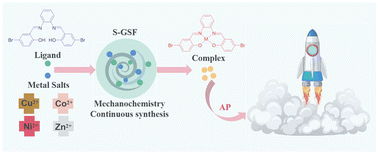Spiral gas–solid two-phase flow continuous mechanochemical synthesis of salophen complexes and catalytic thermal decomposition of ammonium perchlorate†
Abstract
Although mechanochemistry is increasingly becoming an alternative to traditional chemical synthesis, highly efficient continuous mechanochemical synthesis techniques are still rare. In this work, a novel spiral gas–solid two-phase flow (S-GSF) synthesis technique for the mechanochemical synthesis of salophen complexes has been reported, which is an approach for continuous synthesis based solely on airflow impacting the reaction. The synthesis of salophen-Br-Cu was used as a model reaction to optimize the reaction conditions, and three other salophen complexes, namely, salophen-Br-Co, salophen-Br-Ni, and salophen-Br-Zn were synthesized on this basis. The structure and thermal stability of the obtained products were characterized by Fourier transform infrared spectroscopy, X-ray diffraction, UV–vis spectroscopy, nuclear magnetic resonance spectroscopy, scanning electron microscopy, and differential thermal analysis (DTA). The results showed that these complexes can be obtained continuously at a rate close to 4 g min−1, and the corresponding space–time yield is close to 1.2 × 105 kg m−3 day−1. In addition, DTA was used to analyze the catalytic performance of the complex for ammonium perchlorate (AP). The results showed that compared to the conditions for pure AP, salophen-Br-Co and salophen-Br-Cu could significantly reduce the high-temperature decomposition of AP pyrolysis to 77.0 and 102.1 °C, respectively. According to the method of Kissinger calculations, the Ea of AP decomposition decreased from 217.3 kJ mol−1 to 131.0 and 118.5 kJ mol−1, respectively. The TG data at different heating rates were analyzed using two isoconversion methods, i.e. Flynne–Walle–Ozawa (FWO) and Kissinger–Akahira–Sunose (KAS). The activation energies of AP, AP + 10 wt% salophen-Br-Co, and AP + 10 wt% salophen-Br-Cu were calculated. When the conversion degree (α) is between 0.1 and 0.9, the Ea values obtained from the two isoconversion methods are similar and exhibit certain matching. These two isoconversion methods also confirm Kissinger's calculations.



 Please wait while we load your content...
Please wait while we load your content...